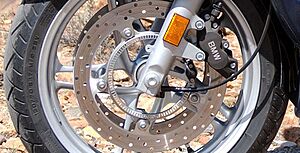Anti-lock braking system facts for kids
An anti-lock braking system (often called ABS) is a very important safety feature in vehicles like cars and motorcycles. Its main job is to stop the wheels from completely locking up when you brake hard. This helps you keep control of the vehicle, which is super important for safe driving. Imagine trying to steer a bike if its wheels were just sliding – it would be impossible! ABS makes sure your wheels keep rolling, even if slowly, so you can still steer away from danger.
Contents
What is ABS and How Does It Work?
ABS is a smart system that helps you stop safely. It works by preventing your wheels from skidding. When a wheel skids, you lose control over steering.
How Does ABS Help You Stop?
When you press the brake pedal very hard, especially on slippery roads, your wheels might try to stop turning completely. This is called "locking up." If your wheels lock up, your vehicle will skid, and you won't be able to steer it. ABS stops this from happening.
The Smart Parts of ABS
ABS uses a few key parts to do its job:
- Speed Sensors: Each wheel has a sensor that constantly checks how fast it's turning.
- Electronic Control Unit (ECU): This is like the brain of the ABS system. It gets information from all the speed sensors.
- Hydraulic Control Unit (HCU): This unit has valves and a pump. It controls the brake fluid pressure to each wheel.
What Happens When You Brake Hard?
1. When you hit the brakes hard, the speed sensors tell the ECU if a wheel is about to lock up. 2. If the ECU detects a wheel slowing down much faster than the others (meaning it's about to lock), it quickly tells the HCU to reduce the brake pressure to that specific wheel. 3. This reduction in pressure allows the wheel to start turning again. 4. Then, the HCU quickly applies the brake pressure again. 5. This process of releasing and applying brake pressure happens many times a second. It's like a very fast "pumping" action, much faster than a human could do.
This rapid on-and-off braking keeps the wheels from locking. It lets them keep rolling just enough so you can still steer the vehicle. You might feel a pulsing in the brake pedal when ABS is working. This is normal!
Why is ABS So Important?
ABS makes driving much safer, especially in emergencies.
Better Control While Braking
The biggest benefit of ABS is that it helps you maintain steering control while braking. If you need to stop quickly and also steer around an obstacle, ABS allows you to do both at the same time. Without ABS, if your wheels lock up, you would just slide straight ahead, unable to steer.
Shorter Stopping Distances (Sometimes)
On some surfaces, like dry pavement, ABS can help you stop in a shorter distance. On slippery surfaces like ice or loose gravel, it might not always shorten the stopping distance, but it will always help you keep control.
A Brief History of ABS
The idea of anti-lock braking has been around for a long time. Early versions were used in airplanes in the 1920s to help them land safely. For cars, the first mechanical anti-lock system was developed in the 1960s.
- 1970: The Lincoln Continental Mark III was one of the first cars to offer an anti-lock braking system as a standard feature. This showed how important this technology was becoming for everyday vehicles.
- Modern ABS: Today, ABS is a standard safety feature on almost all new cars and many motorcycles around the world. It has saved countless lives by helping drivers avoid accidents.
Images for kids
See also
 In Spanish: Sistema antibloqueo de ruedas para niños
In Spanish: Sistema antibloqueo de ruedas para niños










